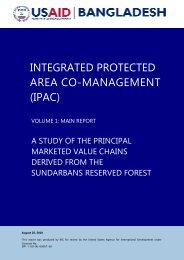Child Equity Atlas - BIDS
Child Equity Atlas - BIDS
Child Equity Atlas - BIDS
Create successful ePaper yourself
Turn your PDF publications into a flip-book with our unique Google optimized e-Paper software.
<strong>Child</strong> <strong>Equity</strong> <strong>Atlas</strong><br />
disparity in the literacy rate and school attendance<br />
was observed in 2001. This disparity on literacy<br />
and school attendance between men and women<br />
has reduced in 2011, with literacy rate (for all<br />
ages) being 54.6 per cent for men and 50.8 per<br />
cent for women, justifying the need to zoom into<br />
disparities at lower levels.<br />
1.4 Comparison of Population Census 2011<br />
and Other Data Sets<br />
1.4.1 A comparison has been made between the<br />
results obtained from the census data to that<br />
of the other data sets in Table 1.1. It is observed<br />
that the estimates obtained from the census data<br />
are comparable to that of the other data sets.<br />
The comparison between the censuses 2001 and<br />
2011 is also presented (Table 1.2). It is important<br />
to note here that substantial improvements have<br />
been noted between 2001 and 2011 in respect of<br />
most of the indicators taken into account, while<br />
disparities are more observable with further<br />
disaggregation by social groups and regions.<br />
1.5 About the <strong>Equity</strong> <strong>Atlas</strong><br />
1.5.1 The <strong>Equity</strong> <strong>Atlas</strong> is an important detailed<br />
insight into the social situation of children, youths<br />
and their families in Bangladesh, based upon the<br />
2011 Census. Central to the atlas are the maps<br />
while the graphs show the remarkable progress<br />
achieved such as in the field of education and the<br />
closing of the gender gap.<br />
1.5.2 The maps are based upon selected indicator<br />
value quintiles with defined value ranges per<br />
indicator. The value ranges per indicator show<br />
incredible inequity in Bangladesh for example with<br />
upazilas values for access to electricity differing<br />
from 98 per cent to 8 per cent. Another example<br />
of unbelievable inequity is the range of female<br />
child labour (who are not attending school) in<br />
Bangladesh - from 0.1 per cent in one upazila to 27<br />
per cent in another - factor of 270 times difference<br />
between two upazilas in the same country.<br />
1.5.3 The analysis also displays new indicators<br />
like the “real child worker” and teenage marriage.<br />
Female Teenage Marriage (married in the<br />
age bracket of 15-19 years) is still very high in<br />
Bangladesh (32.5 per cent on an average but as<br />
high as 55 per cent in one upazila), which shows<br />
higher prevalence in the western part of the<br />
country, suggesting not much relation to poverty<br />
levels but possibly to structural issues of social<br />
norms.<br />
1.5.4 One of the new elements in the study is the<br />
analysis of prevalence of the real child worker,<br />
i.e. children who are working and not attending<br />
school. It is a very important issue that deserves the<br />
concerted effort of families, community leaders,<br />
civil society organizations, private sector leaders,<br />
development partners with the authorities of<br />
Bangladesh. The real child worker situation affects<br />
more than five per cent of children (predominantly<br />
boys). In Dhaka city, about one in six children are<br />
real child workers, while one of the wards shows<br />
43.8 per cent of children as real child workers.<br />
1.5.5 The <strong>Atlas</strong> also puts the Out Of School <strong>Child</strong>ren<br />
(OOSC) into a new context. The proportion of Out<br />
Of School <strong>Child</strong>ren is alarmingly high (almost one<br />
in four). The proportion of OOSC has a correlation<br />
of 0.9 with the composite deprivation index, hence<br />
a clear indicator of deprivation in general. In the<br />
worst upazilas, almost half (45 per cent) of children<br />
are out of school.<br />
1.5.6 In this study, a composite deprivation<br />
index (CDI) of social dimension of poverty has<br />
been created. The CDI is strongly related to<br />
6














